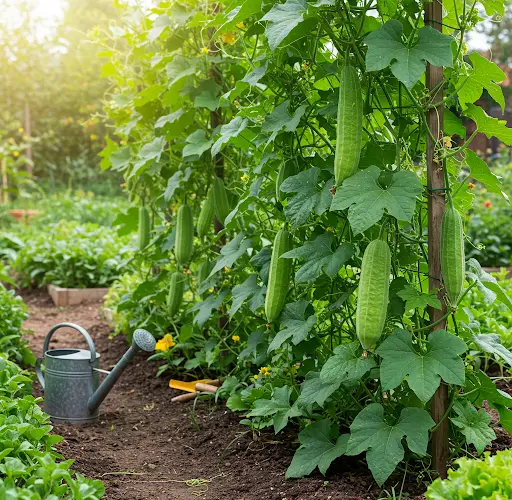Loofah (also spelled luffa) is a fascinating plant that’s both edible when young and useful as a natural sponge when mature. Growing loofah at home is surprisingly simple, and with the right techniques, you can enjoy a heavy yield from just a few plants. Whether you’re gardening in a backyard, a balcony, or even in bags or containers, loofah is a great addition to your home garden.
Here’s a straightforward guide to growing loofah with many fruits—ideal for beginners and seasoned gardeners alike.
Why Grow Loofah?
Loofah is a climbing vine in the gourd family, and it’s popular for two main reasons:
-
Edible fruit: Young loofahs (4–6 inches long) are tender and tasty, great for stir-fries and soups.
-
Natural sponge: Mature loofahs can be dried, peeled, and used as eco-friendly bath or kitchen sponges.
It’s a low-maintenance plant once established, and a single vine can yield dozens of fruits with the proper care.
What You Need to Get Started
-
Loofah seeds (available online or from local seed stores)
-
Containers or garden space with full sun
-
Climbing support such as a trellis, fence, or poles
-
Rich, well-draining soil
-
Organic compost or natural fertilizers
Step-by-Step Guide to Growing Loofah
1. Soak and Start the Seeds
Loofah seeds have a tough outer shell, so soaking them in warm water for 24 hours before planting will speed up germination. You can start them indoors in seed trays or sow them directly outdoors after the last frost.
Germination usually takes 7–14 days, depending on warmth and soil conditions.
2. Choose a Sunny Spot
Loofah thrives in full sun—at least 6 to 8 hours of sunlight per day. Choose a location with ample sunlight and enough space for the vines to spread or climb.
If you’re growing in containers or bags, make sure they’re at least 12–15 inches deep to accommodate root growth.
3. Prepare the Soil
Use fertile, loose, and well-draining soil enriched with organic compost. Loofah plants are heavy feeders, so good soil preparation sets the stage for vigorous growth and high yield.
A soil pH of around 6.0 to 6.8 is ideal.
4. Provide Climbing Support
Loofah vines can grow 10 to 30 feet long, so they need strong vertical support. Install a sturdy trellis, garden netting, or use existing fences or poles. Vertical growing improves air circulation, reduces disease risk, and produces straighter fruits.
If space is limited, even a balcony railing can work with proper vertical setup.
5. Water Regularly but Don’t Overdo It
Keep the soil consistently moist, especially during flowering and fruiting stages. Water deeply once or twice a week, depending on weather. Avoid waterlogging, as soggy soil can cause root rot.
Mulching around the base of the plant helps retain moisture and suppress weeds.
6. Feed for More Fruits
To encourage more flowers and fruits, use organic fertilizers such as compost tea, vermicompost, or diluted seaweed extract. Apply every 2–3 weeks.
Loofah plants benefit from balanced NPK nutrition, especially more phosphorus and potassium during flowering to boost fruit production.
7. Hand Pollinate for Better Results (Optional)
Loofah plants have male and female flowers. Bees usually handle pollination, but you can improve fruit set by hand-pollinating: use a soft brush or cotton swab to transfer pollen from the male to the female flower.
Female flowers are easy to spot—they have a tiny fruit behind the petals.
8. Prune Excess Growth
Remove lower leaves or weak side shoots to encourage the plant to direct energy to fruit development. Keep the plant open and airy to reduce the risk of pests and disease.
Harvesting Your Loofah
You can harvest loofah at two stages:
-
Young fruits (edible): Harvest when they’re about 4–6 inches long. They’re soft, tender, and perfect for cooking.
-
Mature fruits (for sponge): Allow the fruit to fully ripen and dry on the vine. The skin turns brown and becomes brittle. Once fully dry, peel it off and shake out the seeds. Wash the sponge thoroughly and let it dry in the sun.
One healthy plant can produce 10 to 20 or more usable sponges in a single season!
Final Tips for Maximum Yield
-
Start early in the season—loofah needs a long growing period, usually 150 to 200 days.
-
Train vines upward to maximize space and sun exposure.
-
Use compost and natural amendments like crushed eggshells or banana peels to boost soil fertility.
-
Remove the first few flowers to let the plant develop stronger vines before setting fruit.
With just a bit of planning and care, your loofah plant can grow vigorously and reward you with a bountiful harvest. Whether you’re after delicious young gourds or all-natural sponges, this easy-to-grow plant is a wonderful addition to any home garden.



